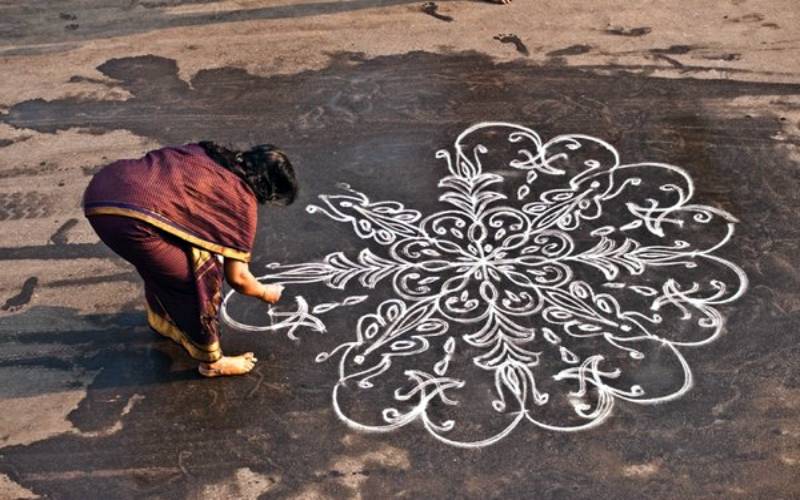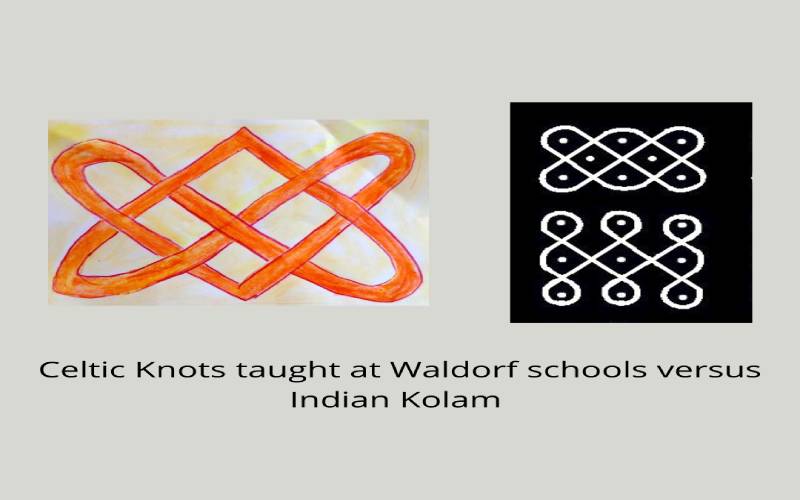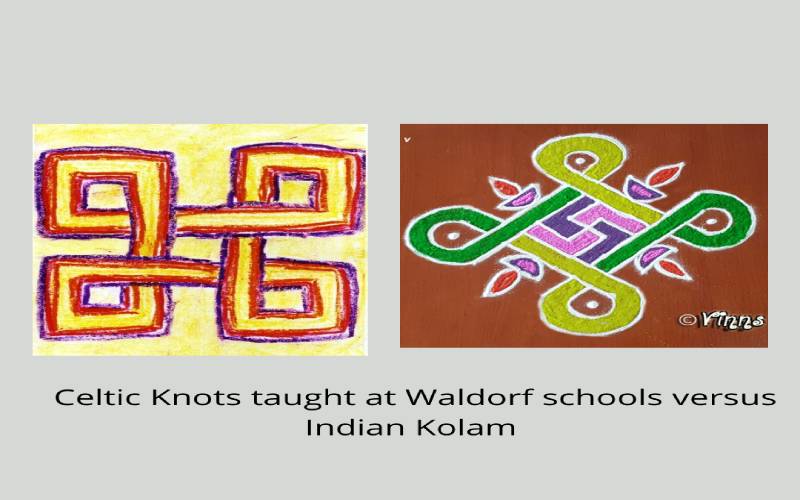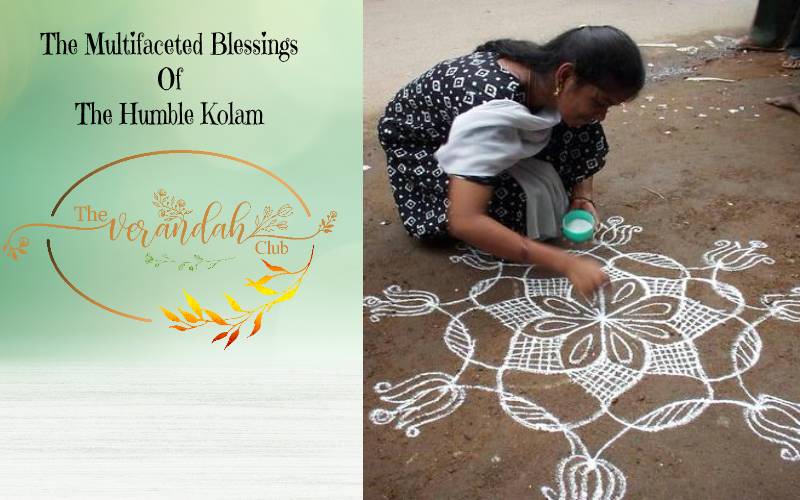
Our ancestors were amazingly explicit and meticulous in conceiving and putting together our way of life. The great saints and sages put together every little detail. There is a scientific reason behind every microscopic practice in our tradition and culture. Every little thing brought harmony not only within oneself but to nature as well. Thus, it leads to the spiritual progress of the people. Let us take the humble and simple kolam and look at its multifaceted blessings on the people practicing it.
The Kolam
Kolam (in Tamil) or Muggu (in Telugu) is a traditional art form that comprises geometrical figures. It is put together with Pulli (dots) and strokes or lines (Neli, Sikku, Kambi). Young girls and women generally practice this art form. It is believed that drawing kolams ushers in good luck and prosperity. Kolams are a vital element for every celebration, be it birth, wedding or festivals and occasions.
Kolams are drawn using raw rice flour (Powdered form) or rice paste in front of one’s home entrance on a flat surface during the break of dawn each day. Each morning, the front entrance of the home is swept clean and sprinkled with water before drawing the kolam. During festivals and special occasions, the entrance is waxed with cow dung and kolams are drawn on it.
Blessings of the Humble Kolam
Kolam to the outsider (Non-practitioner) of Sanatana dharma will look like a fancy decorative piece of art, but there are many hidden boons of practicing this art form.
Physical Health Benefits
Kolam’s geometric pattern may be simple or sometimes complex. Regardless of the size, the person bends the body while drawing or sometimes squats low. They hold this position for a while when drawing and, it unconsciously becomes a form of aasana practice and strengthens one’s back, hips and leg muscles leading to general flexibility.
Kolams are drawn in the wee hours of the morning and, usually at this time of the day, the air is pure and healthy and breathing in that fresh air has immense health benefits. On Fridays and special occasions, cow dung is used to wax the floor of the entrance. One need not stress the significance of the cow dung. Cow dung has scientifically proven antibacterial properties and is a natural disinfectant. It is also used for boosting ones immunity.
Mental Wellness
The kolam drawings comprising of the dots and lines are drawn in a fashion equidistant from one another. It may sound complex to a beginner, but with regular practice, it becomes an artistic hobby.
All age groups can practice this hobby. Practicing kolams regularly is excellent for the brain. One has to remember the number of dots, the flow of lines (Direction) to not just one design, but to different designs that is usually passed over from grandmother to child.
Planning and creating a new kolam design helps in increasing the creativity quotient. There is a kolam called the sikkal kolam, which is very complex to master. The person who masters these kolam will develop problem-solving capacity. Drawing the dots equidistant to each other requires immense focus. Besides that drawing the lines or weaving them to form patterns and forms are just like solving a jig-saw puzzle. You have to first ensure there is symmetry. Then check if each dot is covered and finally if the lines are crossed only once. Thus, our brains get sharper.
Vasudhaiva Kudumbakam
Vasudhaiva kudumbakam means the whole world is a single-family. Our tradition daily practices the art of embracing all living beings. The kolam is usually drawn using rice powder or its paste. This helps the ants, little insects and birds to feed on.
While most of the practitioners of Sanatana dharma are aware of the benefits of kolams discussed above, here is a lesser-known fact of how westerners have embraced our kolams (Or the form very similar to it) since the 1900s. They have been teaching children the forms practiced by our ancestors in school all over the world.
How Western Education Embraces Kolam in a Different Form
All of us would have heard about Maria Montessori. She is an Italian physician and educator. She opened Montessori schools during the 1900s and its a famous educational method followed in India. Just like Maria, there was an Austrian philosopher and thinker named Rudolf Steiner (1861- 1925). He founded the first Waldorf school in Germany in the 1900s. Many schools all over the world now follow the Waldorf system in educating a child.
One important aspect in Waldorf education is the subject, ‘Form Drawing.’ This subject is from Grade 1 to Grade 5 and essentially comprises freehand geometrical shapes that have a very close resemblance to kolams.



The Form Drawings are rhythmic repeated patterns of geometric figures that are interlaced intricately. When one converses with a Waldorf educator or practitioner, they will tell you why this subject has deep reverence.
According to Waldorf educators, Form Drawing adds knowledge and skill to a child, increases independence, and confidence in one’s abilities. Children are encouraged to identify patterns and re-create them on paper. It also enhances the observation, focusing skills, orientation, and fine motor skills of the fingers. It also builds a strong foundation for mathematical skills. Form drawings at schools are also tools used to observe how a child approaches the task of drawing, the effort put in, and the problem-solving capability. It is heartening to see many Indian Waldorf Schools now embrace and teach kolams as one of the forms in the Form Drawing subject.
Although this traditional art form is still practiced in most of the households, many young children are not familiar with this art. With apartments and families becoming nuclear, the children are not exposed to the art form in its true sense. Nowadays, kolam stickers are available and the current generation extensively use the kolam stickers in their pooja rooms. Most of the people think it as a decorative piece (of Indian culture) and know not the true value of drawing and practicing kolam. Thus, the real purpose of the art is lost.

I hope more schools and elders in the families embrace this ancient art of kolams and pass on this particular tradition to the children so that it benefits the youngsters in our country. The children can develop it like a hobby so that our tradition, culture and art stays alive.

I am Vaishnavi Gurusankar, a passionate educator, a wife and a mother. I have over a decade of experience as an educator and have been closely working with teachers and children of all ages. I am also an active parenting blogger and founder of Magical Unicorn, an exclusive parenting blog founded on Indian ethos, values and stories at its core.
NEXT ARTICLE

At the southernmost tip of this mesmerising ensemble lies the majestic Great Nicobar Island, boasting an impressive landmass of about 910 square kilom...

Bharath has always been a land traversed by spiritual masters/ Guru since time immemorial. These spiritual masters have always upheld the core princip...

South India contains its fair share of unique pilgrimage centres. These divine places of worship have a prominent Sthala Purana, devoted followers, di...